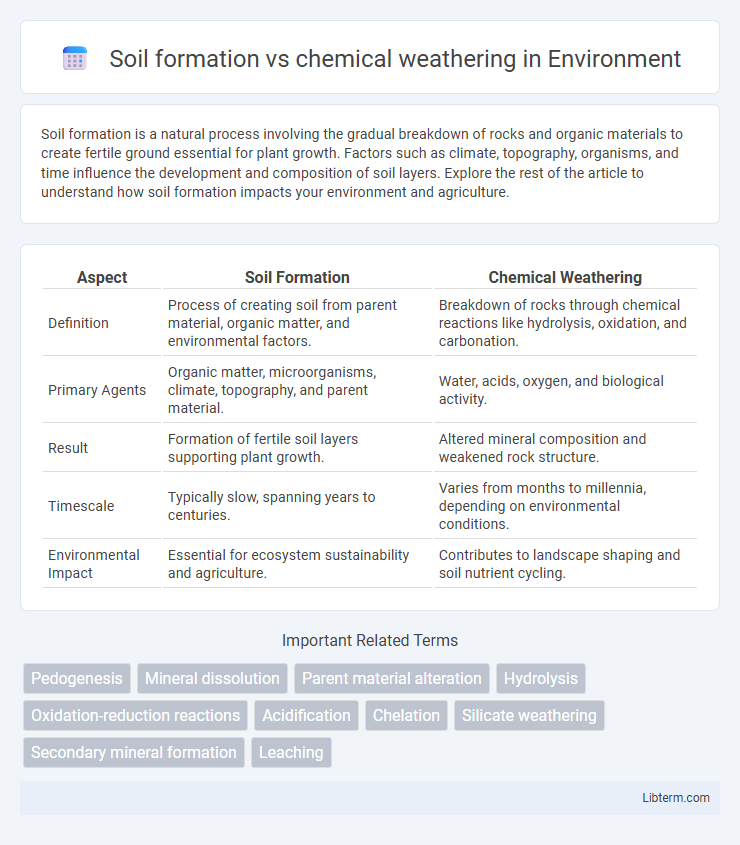Soil formation is a natural process involving the gradual breakdown of rocks and organic materials to create fertile ground essential for plant growth. Factors such as climate, topography, organisms, and time influence the development and composition of soil layers. Explore the rest of the article to understand how soil formation impacts your environment and agriculture.
Table of Comparison
| Aspect | Soil Formation | Chemical Weathering |
|---|---|---|
| Definition | Process of creating soil from parent material, organic matter, and environmental factors. | Breakdown of rocks through chemical reactions like hydrolysis, oxidation, and carbonation. |
| Primary Agents | Organic matter, microorganisms, climate, topography, and parent material. | Water, acids, oxygen, and biological activity. |
| Result | Formation of fertile soil layers supporting plant growth. | Altered mineral composition and weakened rock structure. |
| Timescale | Typically slow, spanning years to centuries. | Varies from months to millennia, depending on environmental conditions. |
| Environmental Impact | Essential for ecosystem sustainability and agriculture. | Contributes to landscape shaping and soil nutrient cycling. |
Introduction to Soil Formation and Chemical Weathering
Soil formation results from the complex interaction of physical, chemical, and biological processes that break down parent rock material. Chemical weathering plays a critical role by altering the mineral composition of rocks through reactions with water, oxygen, and acids, thereby producing essential soil minerals. This process enhances soil fertility by releasing nutrients and contributing to soil structure development, crucial in ecosystems and agriculture.
Key Processes in Soil Formation
Soil formation primarily involves the breakdown of parent material through chemical weathering processes such as hydrolysis, oxidation, and carbonation, which alter minerals into clay, iron oxides, and dissolved ions. Key processes include the decomposition of minerals, organic matter accumulation, and leaching, which redistribute nutrients and shape soil horizons. The interaction of climate, organisms, topography, and time influences the rate and extent of these chemical weathering reactions, critically impacting soil fertility and structure.
Understanding Chemical Weathering
Chemical weathering plays a crucial role in soil formation by breaking down parent rock into smaller mineral particles through processes like hydrolysis, oxidation, and carbonation. This transformation alters the chemical composition and physical structure of rocks, enriching the soil with essential nutrients such as calcium, potassium, and magnesium. Understanding chemical weathering helps explain the development of fertile soils and their variation across different environmental conditions.
Types of Chemical Weathering Reactions
Chemical weathering, a key process in soil formation, involves the breakdown of minerals through reactions with water, acids, and gases. The primary types of chemical weathering reactions include hydrolysis, where minerals react with water to form clay and soluble salts; oxidation, which involves the reaction of minerals with oxygen to form oxides and affect soil color and fertility; and carbonation, where carbon dioxide dissolves in water to form carbonic acid, breaking down carbonate minerals. These reactions significantly influence soil composition, nutrient availability, and the development of soil horizons.
Factors Influencing Soil Formation
Soil formation is heavily influenced by chemical weathering, which breaks down primary minerals into secondary minerals and releases essential nutrients. Key factors impacting soil formation include parent material composition, climate conditions such as temperature and precipitation, and biological activity that drives organic matter accumulation. These elements interact to determine soil texture, structure, pH, and fertility, directly shaping soil development and landscape evolution.
Role of Chemical Weathering in Soil Development
Chemical weathering plays a crucial role in soil development by breaking down parent rock minerals into smaller particles and altering their chemical composition, which enriches soil with essential nutrients like calcium, potassium, and magnesium. This process transforms hard rock into fine soil material, facilitating organic matter incorporation and boosting soil fertility. The intensity and type of chemical weathering depend on factors such as climate, rock type, and vegetation, directly influencing soil texture, structure, and nutrient availability.
Physical vs Chemical Weathering: Main Differences
Soil formation results from both physical and chemical weathering processes, each contributing uniquely to the breakdown of rocks. Physical weathering involves mechanical disintegration, such as freeze-thaw cycles and abrasion, producing smaller rock fragments without altering their chemical composition. Chemical weathering alters the mineral composition through reactions like hydrolysis, oxidation, and dissolution, leading to the formation of new minerals and essential soil nutrients.
Soil Horizons: Products of Weathering Processes
Soil horizons develop as distinct layers through the ongoing process of chemical weathering, which breaks down parent rock material into finer mineral particles and organic matter. The O horizon contains organic residues, the A horizon is enriched with minerals and organic compounds from decomposed material, the E horizon shows leaching of silicate clay and iron, while the B horizon accumulates weathering products such as clay, iron, and aluminum oxides. These layered soil horizons represent the stratification of weathering products and influence nutrient retention, water movement, and root penetration within the soil profile.
Environmental Impact on Weathering and Soil Formation
Chemical weathering significantly influences soil formation by breaking down minerals into smaller particles, enriching soil nutrients and altering its composition. Environmental factors such as climate, temperature, moisture, and vegetation accelerate or decelerate chemical weathering rates, thereby affecting soil depth, fertility, and acidity. Human activities, including pollution and deforestation, exacerbate chemical weathering processes, leading to altered soil quality and increased vulnerability to erosion.
Conclusion: Interconnectedness of Soil Formation and Chemical Weathering
Soil formation is fundamentally driven by chemical weathering processes that break down parent rock into mineral particles essential for soil development. The intertwined nature of chemical weathering and soil formation highlights how mineral transformations regulate nutrient availability and soil structure. Understanding this dynamic relationship is crucial for advancing soil management, ecosystem sustainability, and agricultural productivity.
Soil formation Infographic

 libterm.com
libterm.com